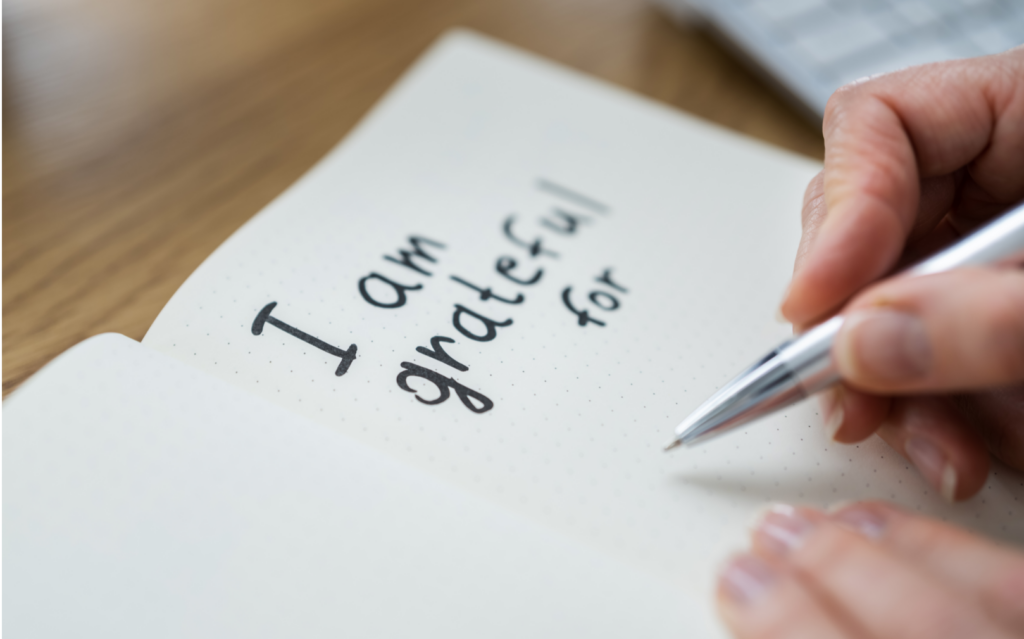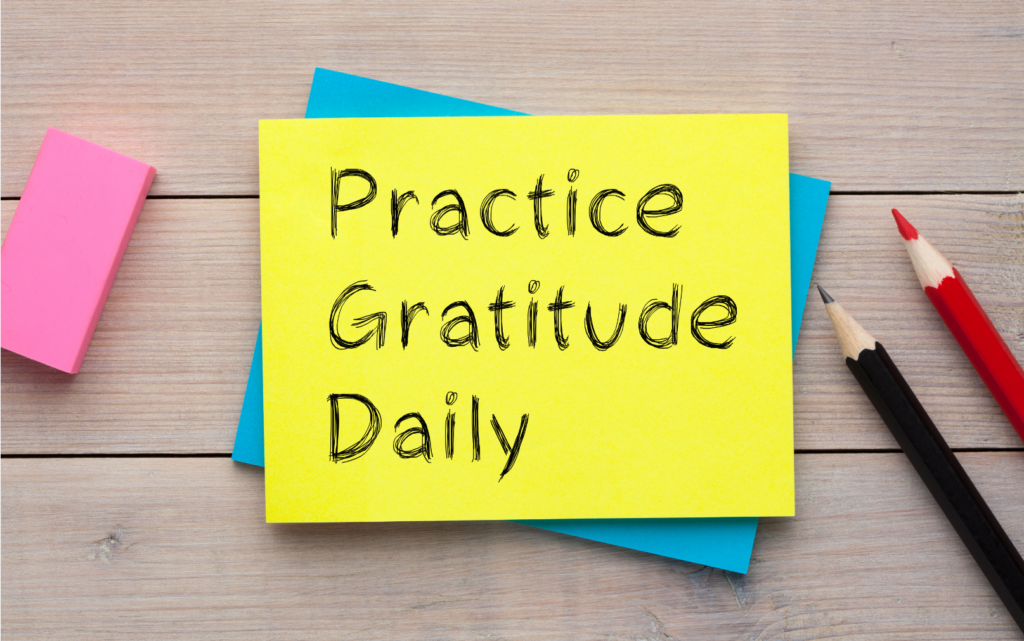Learning to practice gratitude can be a key step towards financial freedom. Two of the most common emotions around money are fear and greed. In particular, when it comes to investing, these powerful feelings have been responsible for many poor decisions. We all know about the advice to “buy low and sell high”, yet often, it’s the very opposite that happens. Remember the dot.com and property bubbles, which ultimately burst?
Feelings of greed and fear do not help our wellbeing. These negative emotions can gnaw away at us, or in more extreme cases, create a rollercoaster of highs and lows. During a very short spell of experimental day training, I felt the full impact of euphoria from quick gains, followed by the gut-wrenching hopelessness of crushing losses. Neither of these provided a sense of wellbeing. In fact, I remember anxiety, sleepless nights, and lack of focus, even on days when I was well in profit.
Gratitude, on the other hand, is a positive emotion. It’s been biologically proven to have long term health benefits, not just psychologically, but possibly even physically too. You can read more in this article from Greater Good Magazine.
Learning to savour what you already have, in terms of both money and time, helps to counter the constant societal pressure of needing more.
The Hedonic Treadmill
The Hedonic Treadmill describes the continuous quest for more or better things, in the search for happiness. But humans have a tendency to return to a relatively stable level of happiness, regardless of major positive or negative events.
Gratitude allows you to step off that treadmill and consciously appreciate what you already have. If you’re not thankful, then you’re depriving yourself of the emotional rewards of gratitude.
All of this is easier said than done. Some have a more naturally grateful disposition than others, so it can take a bit of time and effort.
But there are steps than everyone can take to practice gratitude. It’s best to gradually build a daily habit and not to give up. The results are not necessarily instant, but compound over time.
For a deeper dive into the scientific aspects of gratitude, positivepsychology.com has a great article on the neuro-science behind it.
For now, though, let’s look at 5 easy steps that anyone can practice. To help with this, you can download a one-page gratitude journal at the end of this article.
1. Notice the little things
It’s the little things that make up most of our lives. To place too much focus on the big, significant events runs the risk of life passing by with little enjoyment.
“Enjoy the little things in life because one day you’ll look back and realize they were the big things.”
Kurt Vonnegut, American Writer
Consumerism has taught us to chase bigger and better homes, finer holidays, nicer clothes and newer gadgets. It’s great to have goals and dreams for the future, but if your focus is always on ‘more’ and ‘better’ then you can pile negative pressure on yourself.
It can even breed resentment and jealousy. As Theodore Roosevelt said, “comparison is the thief of joy”. That needn’t just mean comparison against others, but also comparison of what you have now, compared to what you might like to have.
So what little things could you consciously appreciate each day?
- Watch the sun rise or set?
- Have a nap without feeling guilty?
- Be kind to someone who doesn’t expect it?
- Play an easy game of Suduko?
- Scroll through some old photos?
- Water the plants?
There are thousands of daily moments that pass by without consequence. Gratitude is a skill that can be learned by noticing more of those moments.
A good daily habit would be to write down 3 little things that you appreciate. Just be sure to mix them up each day!
2. Practice gratitude to yourself
You can’t always rely on others to offer praise and encouragement. This can be particularly true in business, so practicing self-gratitude on a regular basis can be a real boost.
This can be difficult, though. It’s often said that it’s easier to give praise to others than it is to ourselves. Author, Dr Kristin Neff, recognises that people can worry about feeling vain or even narcissistic when it comes to self-praise.
In her book, Self Compassion: The Proven Power of Being Kind to Yourself, Dr Neff explains that you don’t need to share self-praise with anyone. Acknowledging accomplishments and successes in private, no matter how small, can cultivate a healthy positivity.
Each day, say something nice about yourself. It could be a small congratulatory statement for something you completed, or for help you offered others. Maybe you just made time for yourself and that alone is worth acknowledging.
3. Recall happy memories
Towards the end of 2021, I reflected back on the year and generally felt pretty negative about it. With lingering Covid restrictions, cancelled events and holidays, it was easy to write the year off and hope for better next year.
Then something happened to change my view. I decided to create a film of my family’s best photographs and video clips from that year. Of course, we tend to take pictures of fun and significant events, so this exercise itself can spark gratitude. And for added effect, I added some of our favourite tunes as background music.
It was amazing how many happy and funny moments I had forgotten about. After a few hours of editing, we ended up with an hour-long summary of all the best moments from the year. That really transformed my overall view of 2021, so I repeated the exercise for 2022 and 2023.
I used iMovie for the editing, which is really easy if you’re an Apple fan, but there are loads of free video editing software options.
To practice gratitude on a day-to-day basis, we just need to recall one happy memory to enjoy the benefits. It re-enforces the enjoyment of what we already have. Memories that cost nothing!
4. Practice gratitude for others
Random acts of kindness are known to increase happiness and wellbeing, but you can reap the benefits without even doing anything. Just acknowledging your gratefulness for others has benefits.
One study found that writing a letter of gratitude to others each week resulted in significantly better mental health after 4 weeks. In fact, that was true, even when the letters were not sent to the recipients.

Gratitude journal
If you do choose to write letters of appreciation to others, this article by Grammarly offers some useful hints and tips.
Other ways to show gratitude for others might include:
- Small, personalised gifts
- Tipping well for good service
- Offering favours
- Paying genuine compliments
- Sharing knowledge and skills
Even if you don’t get round to any tangible actions, just noticing who you’re grateful for can have a positive effect. Try identifying one person each day that you’re thankful to have in your life.
5. Notice your own learning and development
Gratitude itself can help promote positive action towards self-development. So, why not capitalise on this and acknowledge your own growth?
Some days are smoother than others and it’s inevitable to face challenges throughout life. The practice of gratitude helps to embrace such challenges and to acknowledge them as learning and growth.
Each day, reflect on something new that you’ve learned. Whether that be additional knowledge or a new skill at work, something about yourself, or an interesting fact. Acknowledging something new means a day is never wasted. However small, each piece of learning represents growth and forward movement.
Summary
Returning to the topic of money, learning to practice gratitude can be one of the most powerful ingredients in the recipe for financial freedom.
Happiness can often elude the richest of people because, as we know, money itself cannot buy happiness. Appreciation for what we have is the starting point, no matter how little that might be to start with.
Click below to download a one-page gratitude journal and try these 5 steps on a daily basis. Stick with it and remember, the positive effects compound over time.
If you would like to explore more about how financial coaching might help you work towards financial freedom, book an initial chat below. Or subscribe to my weekly newsletter for more thoughts and ideas about money and life.






 Production
Production
